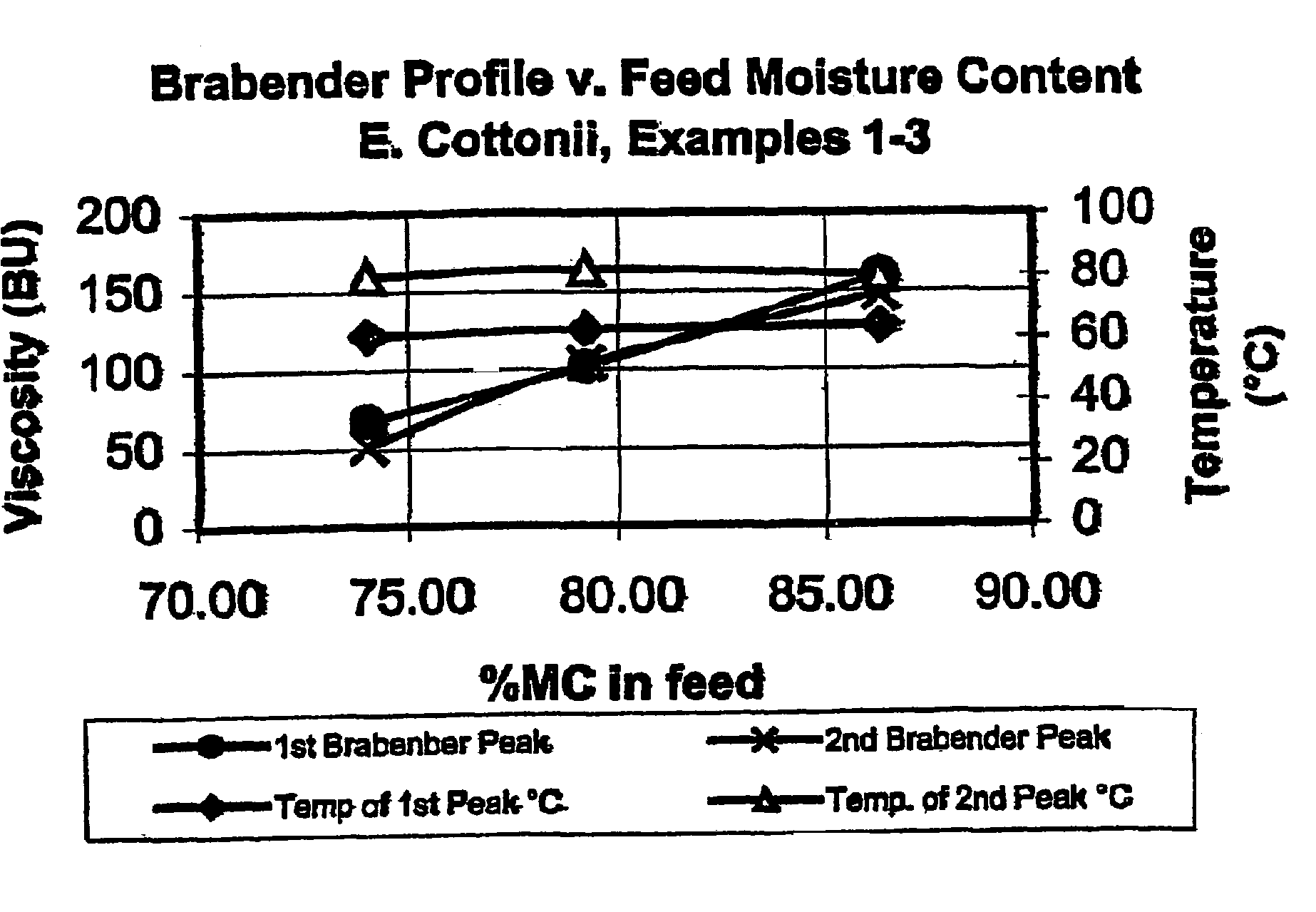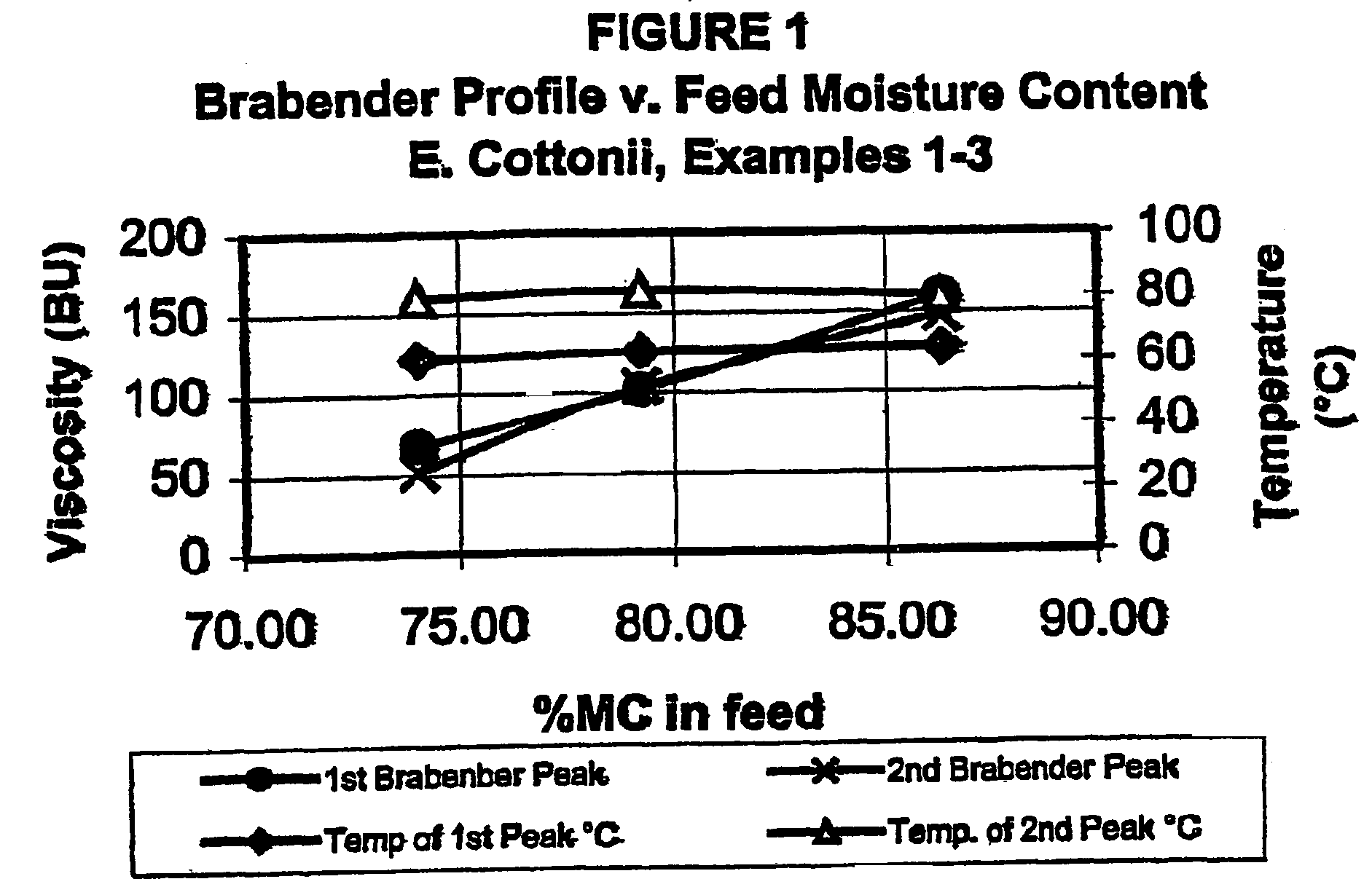Production of carrageenan and carrageenan products
a technology of carrageenan and carrageenan products, which is applied in the field of carrageenan products, can solve the problems of high cost of pure carrageenan extraction on a commercial scale, inability to efficiently process aqueous stream, and limited utility of src products
- Summary
- Abstract
- Description
- Claims
- Application Information
AI Technical Summary
Benefits of technology
Problems solved by technology
Method used
Image
Examples
example 1
Extrusion of High Moisture Content Feedstock
[0073]Processing: Extruder conditions were stable and exit conditions at the TX-52 were easy to maintain.
[0074]Moisture content: Final measurements of percentage moisture in the feedstocks were determined by employing either a moisture balance such as, for example, a Denver Instruments IR200 or a Mettler LJ16 or air oven methods. A typical air oven method is to dry a sample at about 60° C. overnight and determine the % moisture by a simple calculation based on the differences of the wet and dry materials. A slight difference was observed between these two methods. As seen in the table below, since the difference and standard deviation are small, all subsequent discussions will be based on the Average data.
[0075]
Feedstock % moisture contentFeedIR20060° ovenAverageStd. Dev.A86.1186.4286.270.22
[0076]Brabender hydration profiles: Product hydration rate for the feedstock having a moisture content of about 86% was determined in a Brabender Visco...
example 2
Low Moisture Content Feedstock
[0078]Processing: Testing was performed to compare the results obtained using feedstocks with moisture contents lower than those used in accordance with the present invention. No significant processing differences between the three Cottonii feedstocks was observed. Extruder conditions were stable and exit conditions at the TX-52 were easy to maintain for all three products. The lower moisture feedstocks produced drier products at the exit. Exit temperatures at the twin screw increased with the lower moisture feedstocks.
[0079]Moisture content: final measurements of % moisture in the feedstocks showed a slight difference between the IR200 and the air oven method. As the difference and standard deviation are small, all subsequent discussions will be based on the Average data.
[0080]
Feedstock % moisture contentFeedIR20060° ovenAverageStd. Dev.B78.8579.6079.230.53C73.5874.4774.030.63
[0081]Brabender hydration profiles: Product hydration rates for feedstocks ha...
example 3
Effect of Feedstock Moisture Content on Color
[0083]The color of the powder was measured using a Macbeth ColorEye 3000 calorimeter on material that was ground to 99.5% through 100 mesh (150 micron). Powder color is reported in L* units; the lower the L*, the darker the powder. Typical product specifications have L* greater than 74–75. A significant change in product powder color was observed as a function of feedstock moisture content. A substantial darkening of product color was observed upon decreasing the moisture content of the feedstock from about 85% to about 80%. As seen from the table below, a feedstock moisture content of about 86% afforded a product having L* (powder color) of 79.5. Powder color is an aesthetic quality that is important to customer acceptance of carrageenan products that are used in food products; lighter colored products are preferred A change of 1½–2 L* units is readily noticeable by an untrained eye. Knowledgeable end users can detect an even smaller cha...
PUM
| Property | Measurement | Unit |
|---|---|---|
| molecular weight | aaaaa | aaaaa |
| temperature | aaaaa | aaaaa |
| temperature | aaaaa | aaaaa |
Abstract
Description
Claims
Application Information
 Login to View More
Login to View More - R&D
- Intellectual Property
- Life Sciences
- Materials
- Tech Scout
- Unparalleled Data Quality
- Higher Quality Content
- 60% Fewer Hallucinations
Browse by: Latest US Patents, China's latest patents, Technical Efficacy Thesaurus, Application Domain, Technology Topic, Popular Technical Reports.
© 2025 PatSnap. All rights reserved.Legal|Privacy policy|Modern Slavery Act Transparency Statement|Sitemap|About US| Contact US: help@patsnap.com


